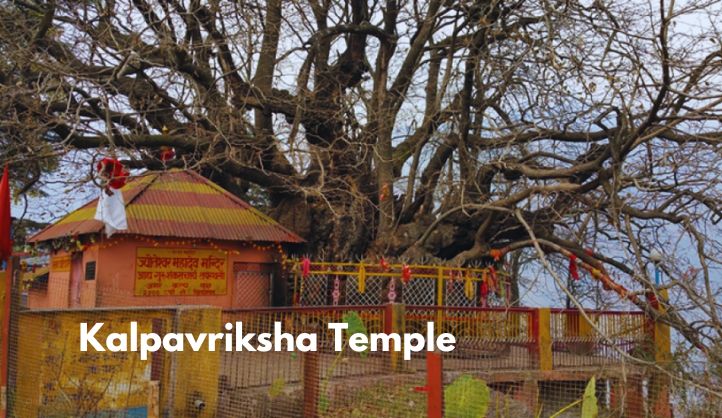Nestled in the serene heights of Uttarakhand, the Kalpavriksha Temple stands as a timeless symbol of divinity and mythology. This ancient temple, dedicated to the wish-fulfilling divine tree Kalpavriksha, holds a special place in the hearts of devotees and tourists alike. Journey with us as we explore the rich history, cultural significance, and spiritual allure of the Kalpavriksha Temple.
The Mythical Beginnings of Kalpavriksha
Origins and Legends
The Kalpavriksha, also known as the “Tree of Life” or “Wishing Tree,” has roots in ancient Hindu mythology. It is believed that this divine tree emerged during the Samudra Manthan, the cosmic churning of the ocean, alongside other treasures like Amrita (the elixir of life). The tree is said to fulfill the wishes of those who seek its blessings with a pure heart.
The Temple’s Historical Roots
The Kalpavriksha Temple in Uttarakhand is thought to be thousands of years old. According to legend, the temple was established by Adi Shankaracharya, a revered Hindu philosopher and theologian, during his travels across India to revive Sanatan Dharma. The temple is perched at an altitude that provides a breathtaking view of the Himalayan ranges, adding to its mystique and spiritual ambiance.
Ancient Design and Modern Restorations
The architecture of the Kalpavriksha Temple reflects the styles of ancient Hindu temples, with intricate carvings and sculptures that depict various deities and mythological scenes. Over the centuries, the temple has undergone several restorations to preserve its sanctity and beauty. Despite these modern interventions, the temple has retained its ancient charm, attracting historians and archaeologists.
The Sacred Kalpavriksha Tree
At the heart of the temple complex stands the revered Kalpavriksha tree. This ancient tree, believed to be thousands of years old, is a focal point for worshippers. Its sprawling branches and verdant leaves create a serene and holy atmosphere, inviting visitors to meditate and seek blessings.
Spiritual Significance and Rituals
Daily Worship and Special Ceremonies
The Kalpavriksha Temple is a vibrant center of worship, with daily rituals that begin at dawn and continue till dusk. Devotees gather to offer prayers, chant hymns, and participate in special ceremonies, especially during festivals like Mahashivratri and Navratri. The temple priests perform elaborate rituals to honor the divine tree and the deities associated with it.
Pilgrimage and Devotion
Pilgrims from all over India and beyond visit the Kalpavriksha Temple to fulfill their spiritual quests. Many believe that tying a thread around the tree’s branches and praying with a sincere heart can make their wishes come true. The temple also serves as a place of solace for those seeking peace and spiritual rejuvenation.
Personal Reflections and Anecdotes
A Pilgrim’s Tale
I remember my first visit to the Kalpavriksha Temple vividly. The tranquility of the place, combined with the sacred aura of the ancient tree, left a profound impact on me. As I tied a thread around the Kalpavriksha’s branch and whispered my wish, I felt a deep sense of connection and peace. This personal experience has made the temple a special place in my heart, and I return whenever I seek clarity and solace.
The Temple’s Impact on the Community
The Kalpavriksha Temple is not just a spiritual hub but also a pillar of the local community. It provides livelihood to many through tourism and has inspired numerous cultural activities. The temple’s festivals are celebrated with great fervor, bringing together people from different walks of life in a harmonious blend of devotion and celebration.
Practical Information for Visitors
How to Reach Kalpavriksha Temple
The Kalpavriksha Temple is accessible by road and is well-connected to major cities in Uttarakhand. The nearest airport is Jolly Grant Airport in Dehradun, and the closest railway station is in Haridwar. From these points, one can hire a taxi or take a bus to reach the temple.
Best Time to Visit
The ideal time to visit the Kalpavriksha Temple is between April and June, and between September and November. During these months, the weather is pleasant, and the natural beauty of the region is at its peak. However, the temple is open year-round, and each season offers a unique charm.
Nearby Places to Explore
Visiting the Kalpavriksha Temple in Uttarakhand offers not just a spiritual experience but also a chance to explore the enchanting surroundings. The region is rich in natural beauty, cultural heritage, and other significant religious sites. Here are some nearby places you should consider exploring:
1. Kedarnath Temple
Kedarnath Temple is one of the twelve Jyotirlingas of Lord Shiva and a part of the Chota Char Dham pilgrimage. Located in the Garhwal Himalayas, it stands at an elevation of 3,583 meters, offering breathtaking views and a deeply spiritual atmosphere.
Things to do:
- Attend the daily rituals and aarti.
- Trek to Vasuki Tal Lake for stunning scenic views.
- Explore the nearby Chorabari Glacier and Gandhi Sarovar.
2. Vasuki Tal Lake
Situated at an altitude of 4,135 meters, Vasuki Tal is a glacial lake known for its pristine beauty. It is believed that Lord Vishnu bathed in this lake, making it a significant site for pilgrims.
Things to do:
- Enjoy a trek to the lake, which offers mesmerizing views of the surrounding peaks.
- Camp by the lakeside and experience the tranquility of the Himalayas.
- Photography enthusiasts can capture the serene landscape and reflections in the crystal-clear water.
3. Guptkashi
Guptkashi is a picturesque town known for its ancient temples and panoramic views of the Chaukhamba peak. It holds great religious significance due to its association with the Pandavas from the Mahabharata.
Things to do:
- Visit the Vishwanath Temple, dedicated to Lord Shiva.
- Explore the Ardhnarishwar Temple, known for its unique idol.
- Enjoy the scenic beauty and peaceful environment of this charming town.
4. Ukhimath
Ukhimath is the winter abode of Lord Kedarnath and Madhyamaheshwar. It is also a prominent pilgrimage site with numerous ancient temples dedicated to various deities.
Things to do:
- Visit the Omkareshwar Temple, where the idols from Kedarnath and Madhyamaheshwar are worshipped during winter.
- Explore the serene surroundings and enjoy short treks in the region.
- Experience the local culture and traditions by interacting with the residents.
5. Tungnath Temple
Tungnath Temple is the highest Shiva temple in the world, located at an altitude of 3,680 meters. It is one of the Panch Kedar temples and offers stunning views of the Himalayas.
Things to do:
- Trek to the temple and enjoy the panoramic vistas along the way.
- Continue your trek to Chandrashila Peak for an even more spectacular view.
- Experience the spiritual ambiance and serene environment of the temple.
6. Chopta
Known as the “Mini Switzerland of India,” Chopta is a beautiful hill station with lush meadows, dense forests, and a peaceful environment. It serves as the base for treks to Tungnath and Chandrashila.
Things to do:
- Trek to Tungnath and Chandrashila for breathtaking views and a thrilling experience.
- Enjoy bird watching and spot various Himalayan bird species.
- Camp amidst nature and experience the tranquility of this unspoiled region.
7. Deoria Tal
Deoria Tal is a stunning high-altitude lake known for its crystal-clear waters and reflection of the Chaukhamba peaks. It is a popular spot for trekking and camping.
Things to do:
- Trek to Deoria Tal and enjoy the mesmerizing reflections of the surrounding peaks.
- Camp by the lakeside and experience the beauty of nature.
- Engage in photography and capture the stunning landscape and wildlife.
8. Triyuginarayan Temple
Triyuginarayan Temple is believed to be the place where Lord Shiva and Goddess Parvati were married. The temple has a perpetual fire, which is said to have been burning since their marriage.
Things to do:
- Visit the temple and witness the eternal flame.
- Explore the nearby Sari village and experience local culture.
- Enjoy the scenic beauty and peaceful surroundings of the temple.
9. Gaurikund
Gaurikund is the starting point for the trek to Kedarnath Temple. It is named after Goddess Parvati (Gauri) and is known for its hot water springs and religious significance.
Things to do:
- Take a dip in the hot water springs, believed to have medicinal properties.
- Visit the Gauri Temple and offer prayers.
- Start your trek to Kedarnath from here and experience the scenic trail.
10. Rudraprayag
Rudraprayag is one of the Panch Prayag (five confluences) of the Alaknanda River and is named after Lord Shiva (Rudra). It is a significant pilgrimage site and offers beautiful views of the confluence.
Things to do:
- Visit the Rudranath Temple, dedicated to Lord Shiva.
- Explore the Koteshwar Mahadev Temple, located in a cave.
- Enjoy the scenic beauty and serene environment of the confluence.
Conclusion
The Kalpavriksha Temple in Uttarakhand is more than just a place of worship; it is a living testament to the rich cultural and spiritual heritage of India. Its ancient roots, coupled with its enduring significance, make it a must-visit destination for anyone seeking a deeper connection with the divine and the natural world. Whether you come as a pilgrim or a traveler, the temple’s serene environment and mystical aura are sure to leave an indelible mark on your soul.
FAQs About Kalpavriksha Temple
1. What is the Kalpavriksha Temple?
The Kalpavriksha Temple is an ancient Hindu temple in Uttarakhand dedicated to the divine wish-fulfilling tree, Kalpavriksha.
2. What is the significance of the Kalpavriksha tree?
The Kalpavriksha tree is believed to grant wishes and is a symbol of divine blessings and prosperity in Hindu mythology.
3. Who established the Kalpavriksha Temple?
The temple is believed to have been established by Adi Shankaracharya, a revered Hindu philosopher and theologian.
4. How old is the Kalpavriksha tree?
The Kalpavriksha tree at the temple is believed to be thousands of years old.
5. What are the best times to visit the Kalpavriksha Temple?
The best times to visit are between April and June, and between September and November, when the weather is pleasant.
6. Are there accommodation facilities near the Kalpavriksha Temple?
Yes, there are several accommodation options ranging from budget guesthouses to comfortable hotels near the temple.





